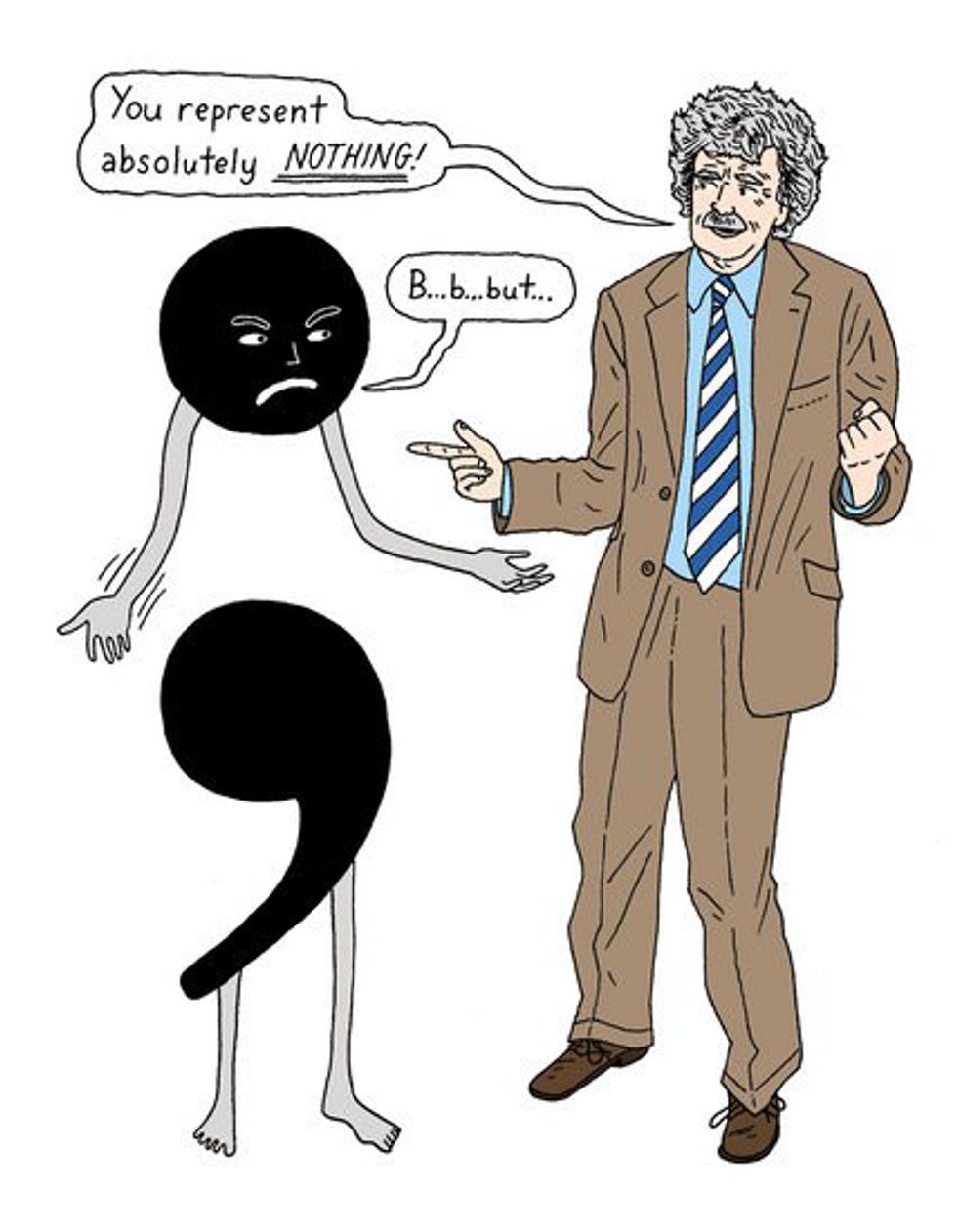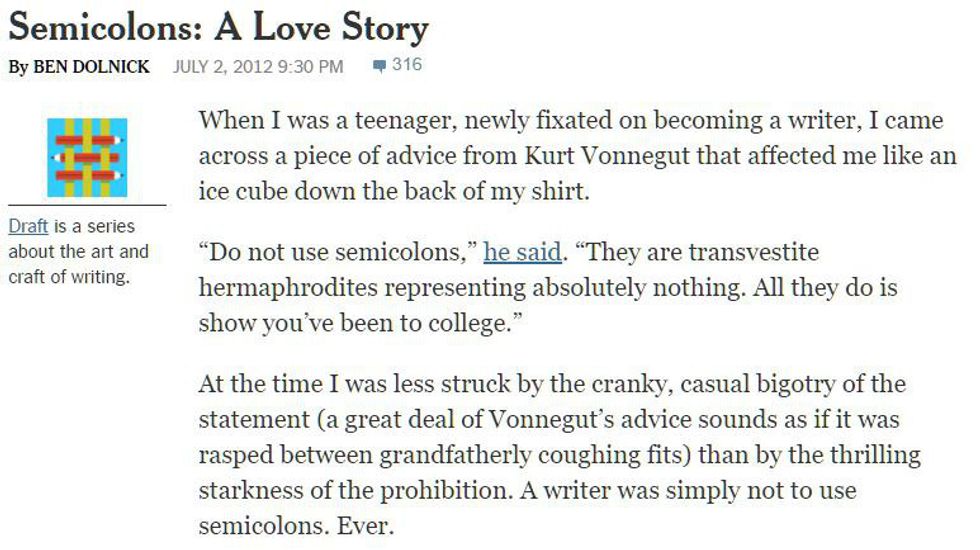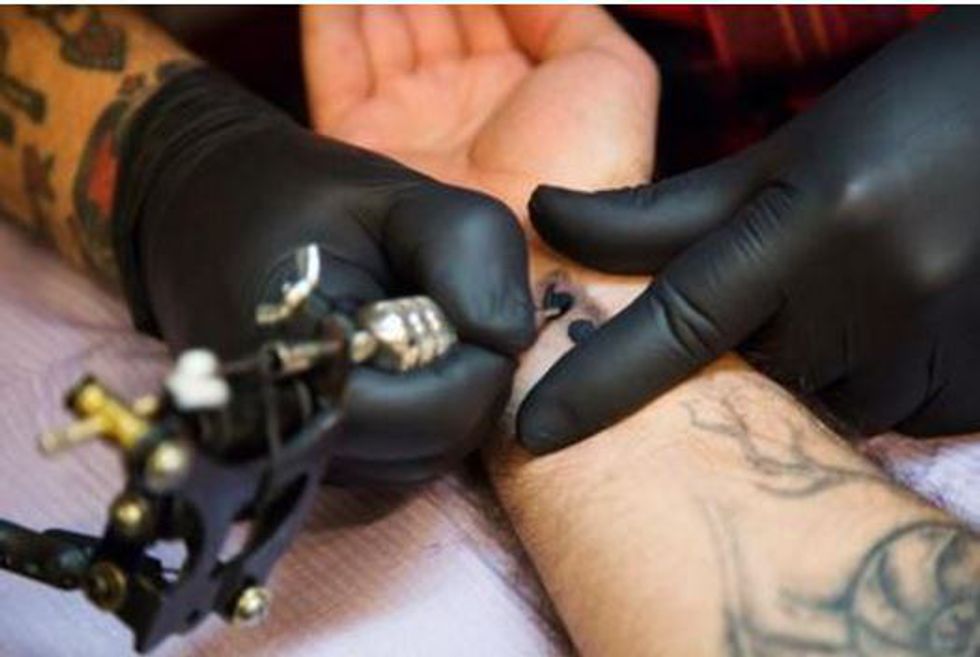In a very specific analysis of two film critics, the American one used nearly two times less semicolons than the British one. Now, why is that? I would hazard a guess and say that it's because we Americans don't teach grammar rules as often or as strictly as our British compatriots. Either that or we're afraid to use semicolons because we don't know a lot about them. So, the following are a couple things to keep in mind when considering semicolons, the three rules you need to know plus all the fun, quirky little facts I could find about them. While I know that not everyone is interested by these nuances, I hope you will take a little time out of your day to learn a bit about my favorite punctuation mark: the semicolon. Who knows, you might even laugh a little! As a quick note, though, there are many accepted spellings of semicolon, such as semi-colon and semi colon, but for the purposes of this essay, I will be referring to it as “semicolon” without a space or hyphen.
1. Semicolon Rule 1: The use for a semicolon is as a way to join two related independent clauses.
When a semicolon is used in this manner, just think of it as the same thing as using a comma and an “and.” The semicolon is used in replace of both of those and joins two sentences that could exist independently on their own. Now, the most important thing to remember for this is that the two clauses must be related. For example, you could say something like “Bob ate one of his three apples; he only has two apples now.” However, you can’t say something like “Bob ate one of his three apples; Jill has four apples.” These two thoughts, the fact that Bob ate an apple and the fact the Jill has four apples has no relation to each other, and as a result, cannot be joined by a semicolon.
2. Semicolon Rule 2: The second use for semicolons is that is a super-comma.
When you use a semicolon as a super-comma, you use it for items in the series which include places that use commas in them. For example, if you were to list all cities with their state (like Chicago, Illinois) in a list using commas, it would get pretty confusing pretty quickly. For example, if you said, “I have visited Chicago, Illinois, Sydney, Australia, and Taipei, Taiwan,” it looks as if you are saying you have visited Chicago and Illinois, two separate entities along with Sydney, Taipei, Australia, and Taiwan. Even worse, it looks like you don’t know comma rules because you put the “and” before Taipei instead of Taiwan. So in cases like these, where commas are included in the item you wish to write in a series, you would you semicolons in place of the series commas., like so: I have visited Chicago, Illinois; Sydney, Australia; and Taipei, Taiwan.
3. Semicolon Rule 3: While periods and commas are always punctuated inside the quotation marks (in America), colons and semicolons always go outside the quotation marks.
This one’s pretty self-explanatory but basically it comes down to this: whenever you are quoting something, the punctuation goes inside the quotation marks unless it’s a semicolon or colon. These are the special cases that belong outside of the quotation (I know, I know, it’s quite weird, and most people don’t even understand to put the punctuation inside the quote to start with. But this just goes to show the semicolons is always the exception...kind of like the Mongols, if you’ve ever watched Crash Course World History).
4. Semicolon Fun Fact 1: Interestingly enough, unlike any other punctuation mark semicolons are the only punctuation marks for which there is always a way to replace it up by another form of punctuation.
For example, you could simply use a comma and an “and” or a period instead of joining two related independent clauses with a semicolon. Instead of listing out phrases with commas in them, you could always rewrite the sentence to either not include the states/countries or simply rewrite the phrase to not include commas in the phrases. But isn’t it more fun and sophisticated to use a semicolon?
5. Semicolon Fun Fact 2: Kurt Vonnegut Jr. once.famously said “First rule: Do not use semicolons. All they do is show you've been to college.”
I find this wildly funny, and entirely inaccurate. I, myself, have not gone to college and am fluent in the correct uses of semicolons. But if you ever need a reason to laugh at your friends’ inability or hesitance to use semicolons, I suggest quoting this line. It’s fairly easy to memorize and recite. Then you can ask them if they’ve gone to college. And is that the reason why you don’t know how to use semicolons? Because you haven’t gone to college?
6. Semicolon Fun Fact 3: "Semicolons: A Love Story" chronicles how a writer, Ben Dolnick, began to hate semicolons under Kurt Vonnegut’s guidance and learned to love them after reading William James.
I suggest going over and giving this one a read. It’s published in the New York Times and easily accessible online. It has quite a few insightful thoughts within and really goes to show how interesting semicolons could be.
7. Semicolon Fun Fact 4: The semicolon was first printed in Greek and Roman classics by Aldo Manucci, a pioneering Italian typesetter, in the 1490s. Furthermore, the mark first appears in printed English during the late 1600s.
It’s pretty neat to think about how long the semicolon has been around, isn’t it? WIth all of this history, hopefully the semicolon won’t die off with our generation; the only way to prevent such a tragedy is by continuing to teach and learn the uses of semicolons and actually using the punctuation mark.
8. Semicolon Fun Fact 5: In the early 17th Century, writers appear to actually use colons, semicolons, and commas interchangeably.
The punctuation they chose to use actually depended on pauses for breath rather than any real syntactical structure for the sentence. It certainly was a much simpler time.
9. In 2008, Rue89, an online French newspaper, announced that the Nicolas Sarkozy government was going to require “at least three semicolons per page in official administrative documents” as an amazing April Fool’s hoax.
The title loosely translates to "The Elysee launches a mission to save the semicolon," and the subheading translates to "According to a letter that has procured Rue89, Sarkozy wants to rehabilitate this punctuation in administrative documents." Note: I don't actually speak French, so if I'm wrong about any part of the translation, I apologize in advance.
The article caused widespread panic and a great increase in interest in how to use semicolons correctly.
10. Project Semicolon is a faith-based not-for-profit movement that attempts to inspire hope and love for people struggling with and suffering from addiction, self-harm, suicide, and various other mental illnesses.
Their motto is actually “A semicolon is used when an author could’ve ended a sentence but chose not to. You are the author, and the sentence is your life.” It was created by Amy Bleuel who wanted to honor her father whom she lost to suicide through getting a semicolon tattoo, and the project eventually came to represent hope for many people suffering from many different mental illnesses.
























